How to Translate Videos to English: A Simple and Easy-to-Learn Tutorial
💥In the tide of globalization, the cross-border dissemination of video content has become increasingly significant. Translating videos to English not only enables a broader international audience to understand the content but also fosters cultural exchange and integration. 😎So, how to translate videos to English?💡 This article will offer you a comprehensive overview from various perspectives, helping you to easily master this skill!
How to Translate Videos to English: A Simple and Easy-to-Learn Tutorial
In today’s era dominated by globalization, videos, with their intuitive and vivid nature, have become an important medium for transcending linguistic and cultural barriers. Translating video content to English is not just a matter of substituting words but a complex process that integrates linguistics, cultural studies, and technical operations. The key is to accurately retain the essence of the original video while ensuring that the translation is natural and engaging in the new linguistic context. If you still don’t know how to translate videos to English, keep reading❕
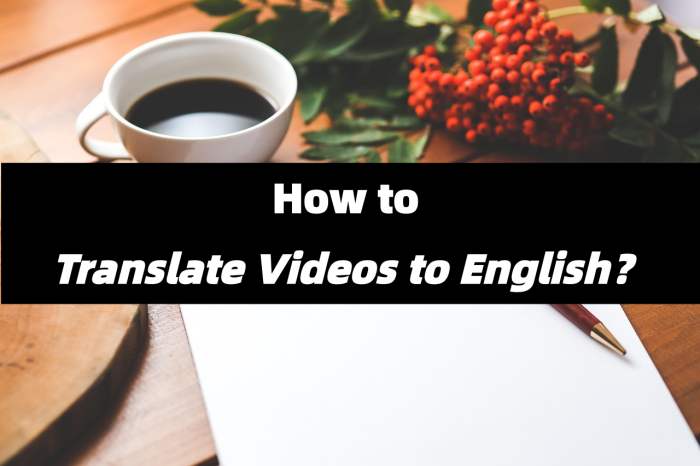
📢 Preparation Work for Video Translation
✨Familiarize Yourself with the Video Content
◼ Watch the Video: Carefully watch the video to grasp its theme, style, and emotional tone. Whether it is a documentary, movie, or instructional video, understanding the content is the cornerstone of translation.
◼ Outline the Structure: Analyze the video’s structure, including the introduction, body, and conclusion. Identify key information in each part to ensure logical coherence during translation.
✨Define the Target Audience
◼ Language Proficiency: Consider the English proficiency level of the target audience. If the audience consists of English beginners, the translation should be as simple and understandable as possible; for professionals, the appropriate use of technical vocabulary is acceptable.
◼ Cultural Background Differences: Understand the cultural background of the audience to avoid using vocabulary and expressions that may cause misunderstandings. Consider adding cultural notes to help better understand the cultural elements in the video.
✨Collect Relevant Materials
◼ Technical Terminology: Gather relevant technical terminology for the fields that may be involved in the video to ensure the accuracy and consistency of technical vocabulary during translation. This can be done by consulting professional dictionaries, academic literature, and industry reports.
◼ Background Knowledge: Understand the thematic background knowledge of the video, including historical, geographical, and social information, which will help accurately understand the video content and avoid translation errors caused by a lack of background knowledge.
🔑 How to Translate Videos to English: Method & Steps
✅ TranslateAI
An AI translation software for the Windows system, it supports over a hundred languages and covers various translation modes such as images, text, Word, and PDF. It also includes tools for conversion, recognition, and compression to meet diverse needs.
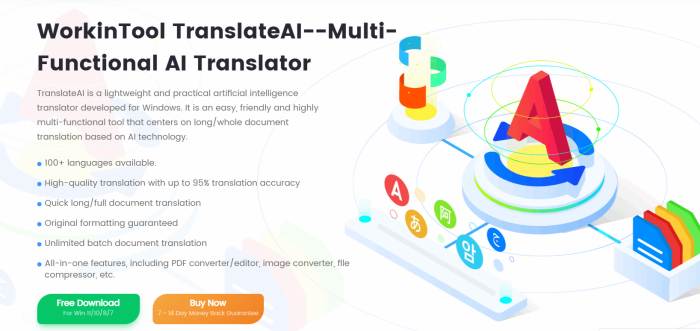
◻ Step 1: Open the software and find and click on “Video” under the “Audio & Video” category in the “Translation” interface.
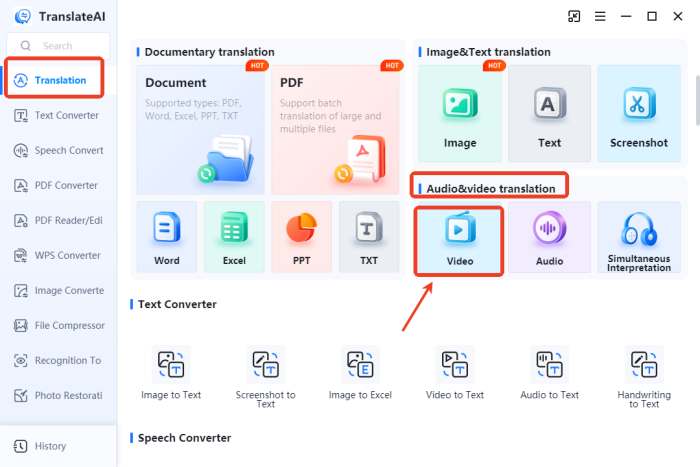
◻ Step 2: Select the target file to add, supporting multiple formats and batch operations, with a maximum of 200MB and 3 hours per file.
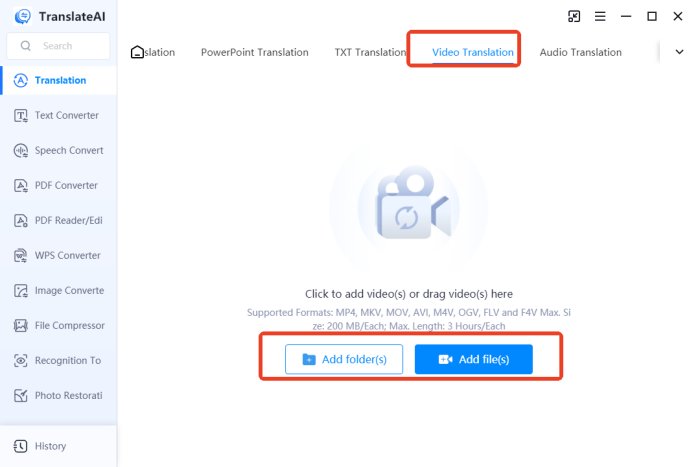
◻ Step 3: Set the source language according to the video content and then select the translation language as “English.”
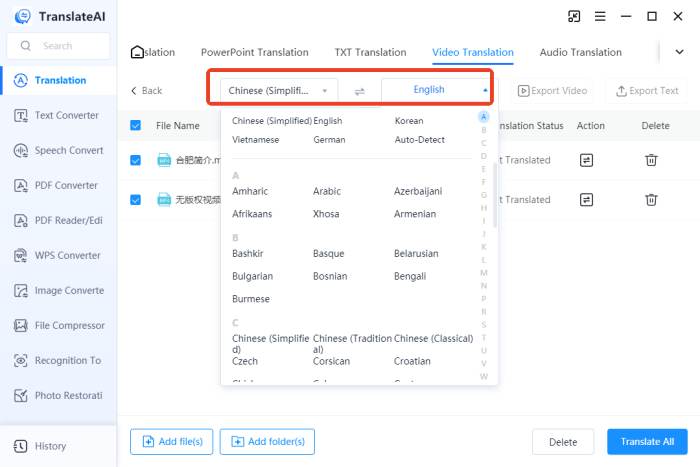
◻ Step 4: Press “Translate All” at the bottom of the interface. When “Translated” is displayed, the translation is complete.

◻ Step 5: Choose to export in video or text format as needed, with adjustable settings for ontent, format, path, and more.
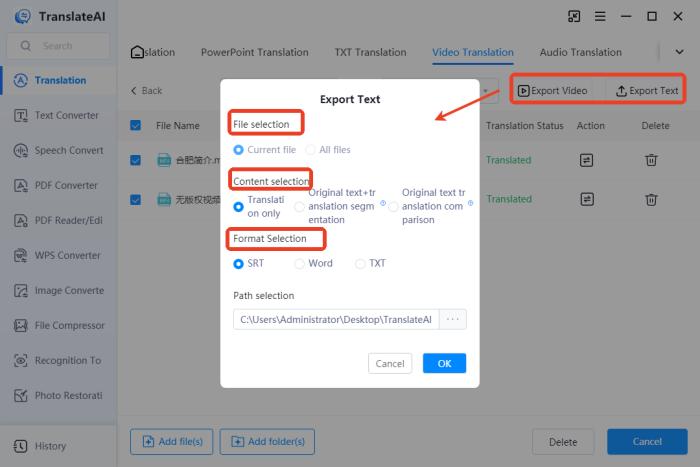
🔔 Optimization Methods and Inspection Points After English Translation of Videos
| 📍 Dimension | 🔎 Measures | 🎊 Expected Effect | 🔔 Precautions |
| ▫ Language Proofreading and Review | Invite professionally qualified native English speakers to check the translation sentence by sentence for grammar, spelling, and punctuation, optimizing stiff expressions to make them more in line with English expression habits. | Reduced grammar errors in the translation, improved sentence fluency, and enhanced readability, making it closer to native English. | Select proofreaders with experience in the relevant field and familiarity with the video’s content and style. |
| ▫ Cultural Adaptation Verification | Organize personnel familiar with the target audience’s culture to review the translation and presentation from their cultural perspective, modifying vocabulary, expressions, and imagery that may cause cultural misunderstandings. | Increased likelihood of the video being accepted in the target cultural environment, reduced cultural barriers, and facilitated dissemination. | Verifiers should have a deep understanding of the target culture’s values and customs. |
| ▫ Technical Synchronization Testing |
Utilize professional tools to detect the synchronization of subtitle display with dialogue, the volume of voice-over with sound effects, and lip movements, while troubleshooting potential technical issues such as stuttering and garbled code. |
Improved coordination between subtitles, dubbing, and pictures, providing a relatively smooth and comfortable viewing experience for the audience and reducing interference from technical issues. | Testing should cover multiple playback devices and different network environments. |
| ▫ User Feedback Iteration | Collect opinions and suggestions from the target audience during test screenings and make targeted adjustments to the translation, presentation, and technical effects based on the feedback. | Overall improvement in video quality, better alignment with audience needs and preferences, contributing to enhanced video reputation and dissemination. | Ensure the feedback sample is diverse and representative, and analyze and process the feedback promptly. |
📝 Common Problems and Solutions in Video Translation
📌 Q1: What are the language proficiency requirements for video translators?
A1: Video translation requires translators to have a solid grasp of both the source and target languages, accurately comprehending the semantics and grammar of the source language, and expressing them naturally in the target language. They should also be well-versed in the cultural and expressive nuances between the two languages to prevent misunderstandings.
📌 Q2: How should colloquial expressions in videos be handled during translation?
A2: Colloquial expressions are prevalent in videos. The translation should resonate with the language habits of the target audience. For expressions with regional or contextual significance, avoid direct literal translations; instead, opt for phrases that align with everyday communication to facilitate audience comprehension.
📌 Q3: What are the key points to consider when translating videos involving multiple languages?
A3: When translating videos with multiple languages, focus on the transition and coherence between different languages. Each language has its unique structure and logic, so maintain content coherence and clear logic when switching to avoid confusion arising from linguistic differences.
📌 Q4: How can one effectively self-check after completing a video translation?
A4: First, review the translation for typos and grammatical errors. Then, compare it with the original to ensure all information is conveyed. Next, assess the naturalness and cultural relevance from the audience’s perspective. Finally, verify the synchronization with the video.
📌 Q5: How can one ensure the translation matches the video duration?
A5: Pay attention to how well the translation matches the video’s duration. It should neither be too long, causing a disconnect between the visual and audio, nor too short, leading to omitted information. Adjust the translation length reasonably according to the video’s pace to convey the original meaning accurately.
👀 Conclusion
Translating videos to English is a task that demands both precision and creativity, involving planning and execution across various stages such as transcription, language conversion, and quality assurance. 🌈Through translation, video content can transcend linguistic barriers, reach broader audiences, and maximize its value, serving as a bridge connecting the world. 👍TranslateAI mentioned in this article is worth trying; It is user-friendly, feature-rich, and performs well in terms of speed and accuracy. It adeptly handles translation needs across various scenarios.




